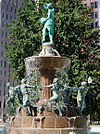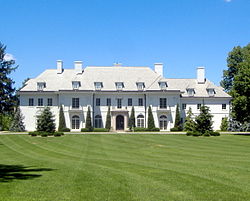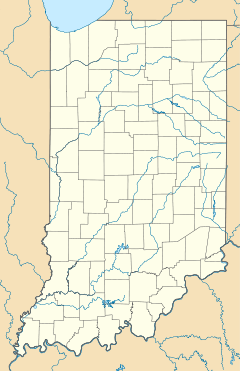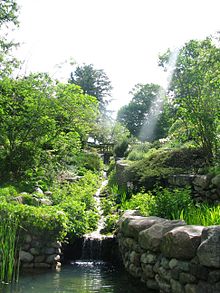- Oldfields
-
Oldfields (Josiah Kirby Lilly, Jr. House)
Location: 1200 W. 38th St., Indianapolis, Indiana Coordinates: 39°49′42″N 86°11′7.5″W / 39.82833°N 86.185417°WCoordinates: 39°49′42″N 86°11′7.5″W / 39.82833°N 86.185417°W Area: 32 acres (13 ha) Built: 1913 Architect: Davis, Lewis Ketcham; Olmsted Brothers Architectural style: Late 19th And 20th Century Revivals Governing body: Private NRHP Reference#: 00000676 and 03001041 Significant dates Added to NRHP: June 15, 2000 (original)
July 31, 2003 (increase)[1]Designated NHLD: July 31, 2003[2] Oldfields also known as Lilly House and Gardens, is a 26 acre historic estate and house museum on the grounds of the Indianapolis Museum of Art in Indianapolis, Indiana, United States. The estate, an example of the American country house movement of the late 19th and early 20th centuries, was designated a U.S. National Historic Landmark in 2003.[3]
Oldfields was built between 1909 and 1913 by architect Lewis Ketcham Davis for the family of Hugh McKennan Landon, who occupied the home from 1913 until 1932 when it was sold to J.K. Lilly, Jr.[4] Lilly, the late Indianapolis businessman, collector, and philanthropist, renovated and expanded the estate throughout the 1930s and 1940s, updating interiors as well as adding a number of new buildings to the grounds.[4]
Now known as Lilly House, the 22-room mansion has undergone historic restoration and is now open to the public on the campus of the Indianapolis Museum of Art. The historic house is currently interpreted to reflect the 1930s era when the Lilly family occupied the residence.[5] The rest of the Oldfields estate, which was given to the Art Association of Indianapolis by Lilly's children in 1967, now makes up a major portion of the Indianapolis Museum of Art campus.[3] In addition to the home's significance as a representation of the American country house movement, Oldfields' gardens and grounds are a rare example of a preserved estate landscape designed by Percival Gallagher of the Olmsted Brothers firm. [2]
Contents
History
Oldfields was established as part of the Town of Woodstock, a tract of land purchased and developed by Hugh McKennan Landon and Linnaes C. Boyd around 1910 as a suburban neighborhood north of Indianapolis.[3] The area was adjacent to the 555 acre Crown Hill Cemetery and the White River, and included residential lots, a reservoir, and a country club. Landon reserved 26 acres, or about half of the land, for the construction of Oldfields, which was completed around 1913.[3]
In 1932, in the midst of the Great Depression, Josiah Kirby Lilly, Jr. purchased the estate. In spite of the economic times, Lilly undertook a number of renovation and expansion projects on the property, including an extension to the south for a new library, renovation of the stair hall and front entrance, and the addition of a vestibule that aligned the entrance with the allée at the front of the property.[3]
In the 1950s Lilly redecorated several rooms in keeping with the tastes of the time. Bookshelves were removed and walls repainted in order to make room for an expanding portrait collection. Additionally, muralist Douglas Riseborough was employed to update the stair hall and the loggia with murals depicting the surrounding grounds and gardens.[3] While most of these renovations were changed in subsequent decades, the mural illustrating views of the allée can still be seen in the loggia.
In 1967, following the deaths of Lilly and his wife, the Lilly children, Ruth Lilly and J.K. Lilly III, gave the estate to the Art Association of Indianapolis to serve as the new art museum.[3] Called the "Lilly Pavilion of Decorative Arts," the house served as exhibit space at the time that the association changed its name to the Indianapolis Museum of Art in 1969. In the years that followed the exhibits focused more on decorative arts and less on the historic aspects of the home and garden. Beginning in the 1980s and 1990s, planning began to restore Oldfields to its former condition.[3] In 2002 the historic home reopened to the public, and in 2003 it was designated as a national historic landmark.[2] The property is considered a historic district and includes 10 buildings and 28 other contributing resources. [4]
Country house movement
Oldfields is an exemplary representation of an estate constructed during the Country Place Era, or the American country house movement, which took place from approximately 1885 to 1939. The country house movement was a reaction to the expanding industrialization and urbanization of America following the Civil War. As industrialists and businessmen became more wealthy at the turn of the twentieth century, it became increasingly popular to invest in large, country estates located outside of cities.[6] It was a way to return to a simpler life, far from the increasingly crowded, dirty, industrialized city. As more families began to own automobiles it became even more feasible to live in the country while remaining involved in city life.[3]
Country houses during this era were often palatial, with expansive estates and architecturally designed gardens. Many estates were self sufficient farms as well. While the Biltmore Estate in Asheville, North Carolina is considered to be the first and most grand example of the Country Place Era, estates as small as twenty acres could also be reflective of the movement.[6] Oldfields is one such example.
Structure
Lilly House was designed by Landon's brother-in-law, Lewis Ketcham Davis, in the French Château style. The house is positioned on a bluff overlooking the White River, taking advantage of expansive views to the west.[3]
The house includes a service wing, pavilions on the east and west with access to balconies from the second floor, and a large terrace atop a garage and service area. While occupied by the Landon family, the main floor originally included a music room, library, sunroom, living room, dining room, kitchen, and porch. The second floor was made up of private suites, bedrooms, bathrooms, the servants suite, and a study. A third floor ballroom was also present in the Landon home and was used for storage during the Lilly's occupancy. At that time the estate also included a formal garden, greenhouse, tennis court, and several out buildings.[4]
Following the renovations of J.K. Lilly, Jr., components of the main level included a great hall, game room, library, drawing room, loggia, dining room, kitchen, and servants quarters as well as an altered stair hall and entrance.[3]
Grounds and gardens
The first garden on the estate was included as part of the initial design by architect Lewis Ketcham Davis. This formal sunken garden was located to the south of the home and was connected by a series of pathways, flights of steps, and a limestone bridge. The focus of the garden was a circular fountain, surrounded by arbor trellises, two Hermes sculptures, and a shaded bench.[3] The garden has been restored and remains true to its former design.
The landscape remained largely unchanged until Percival Gallagher of the Olmsted Brothers Firm was hired in 1920 by Landon's second wife, Jessie. Gallagher's plans for the property balanced formal components, such as the extravagant allée, and more informal components such as the ravine garden. The ravine garden consists of a watercourse lined with an extensive pattern of rocks, flowers, shrubs, and trees, as well as a meandering path and bridge.[3]
The Grand Allée, or vista, at the front of the property added an increased sense of formality to the estate, while also serving the more practical function of blocking unwanted sounds and views of Michigan Road. A circular fountain and sculpture of the Three Graces were installed at the end of the allée, positioned in front of a line of evergreens which block the road. Double rows of Dutch elms were planted along each side of the allée, framing the view of the house and drive. Behind the elm trees on both sides of the allée Gallagher designed border gardens with meandering paths, a multitude of flower beds, and additional sculptures. The border gardens were meant to entice visitors to explore the paths before emerging at the far end of the allée.[3]
When the Lillys purchased the property in 1933 the gardens and grounds were just beginning to mature. The family left the gardens largely unaltered other than the addition of several sculptures throughout.[4] Lilly also constructed a number of new buildings on the grounds, expanding the greenhouse significantly. In 1939 Newfield was constructed as a residence for Joe Lilly and his family. In 1940 a recreation building was built in the south pasture that housed an indoor pool, game room, and exercise room. Outside of the recreation building was an outdoor pool, tennis court, and Four Seasons garden.[4]
Today
Today Oldfields makes up a major portion of the main Indianapolis Museum of Art campus, with Lilly House located adjacent to the main museum building and 100 Acres, the Virginia B. Fairbanks Art and Nature Park. The house features eight furnished historic rooms on the main level including the stair hall, great hall, game room, library, drawing room, loggia, dining room, and kitchen, the majority of which reflect the 1930s period of the Lilly family's occupancy. Nearly 90 percent of the furnishings and objects are original to the house and were used by the Lilly family.[5] The upper level of Lilly House features historical and interactive exhibits detailing the American Country Place era, Oldfields' development as a country estate, and Indianapolis in the early 20th century. The second level also includes a sampling of Lilly's collections of books, gold coins, military miniatures and nautical items.[5] Oldfields' gardens and grounds are preserved and maintained by the museum and are interpreted to reflect the intentions of Percival Gallagher's design. [5]
See also
References
- ^ "National Register Information System". National Register of Historic Places. National Park Service. 2009-03-13. http://nrhp.focus.nps.gov/natreg/docs/All_Data.html.
- ^ a b c "Oldfields (Josiah Kirby Lilly, Jr. House)". National Historic Landmark summary listing. National Park Service. http://tps.cr.nps.gov/nhl/detail.cfm?ResourceId=-276937780&ResourceType=District. Retrieved 2009-09-04.
- ^ a b c d e f g h i j k l m n Brooks, Bradley C. (2004). Oldfields. Indianapolis Museum of Art.
- ^ a b c d e f Carolyn Schlief, Carolyn Pitts, and Patty Henry (September 10, 2001), National Historic Landmark Nomination: OldfieldsPDF (32 KB), National Park Service and Accompanying photosPDF (32 KB)
- ^ a b c d "Oldfields-Lilly House & Gardens". Indianapolis Museum of Art. 2010. http://www.imamuseum.org/art/collections/oldfields-lilly. Retrieved 2010-12-19.
- ^ a b Aslet, Clive (1990). The American Country House. New Haven: Yale University Press.
Further reading
- Hewitt, Mark Alan. (1990). The Architect and the American Country House. New Haven: Yale University Press.
- Giffin, Marjie Gates. (1981). Water Runs Downhill: A History of the Indianapolis Water Company and Other Centenarians. Indianapolis: privately printed.
- Griswold, Mac, and Eleanor Weller. (1991). The Golden Age of American Gardens: Proud Owners, Private Estates, 1890-1940. New York: Harry N. Abrams, Inc.
- Moss, Roger. (1990). The American Country House. New York: Henry Holt and Company.
- Silver, Joel. (1993). J.K.Lilly, Jr., Bibliophile. Bloomington: Indiana University.
- The Story of the Indianapolis Museum of Art. Indianapolis: Indianapolis Museum of Art, 1998.
External links
Indianapolis Museum of Art outdoor artworks Indianapolis Museum of Art & Grounds Above and Below • La Hermana del Hombre Bóveda • LOVE • Memories of Prague • Mother and Child • Numbers 1-0 • Snowplow • Stumbling Man • Sutphin Fountain • Two Figures • Two Lines Oblique Down, Variation IIIOldfields: The J. K. Lilly Jr. Estate Antique Wellhead • Copy of Diana of Versailles • Diana with Dog • Female and Male Herm • Fountain • Four Seasons • Landon-Era Birdbath • Nymph and Fawn • Sundial, Boy With Spider • The Three Graces • Pair of Urns100 Acres: The Virginia B. Fairbanks Art and Nature Park Bench Around the Lake • Eden II • Free Basket • Funky Bones • Indianapolis Island • Park of Laments • Stratum Pier • Team Building (Align)Artworks on Loan East Gate/West Gate • Mega-Gem • Portrait of History • Sewall Memorial Torches • Spaces with IronDe-accesioned Artworks Broken Walrus II • Holistic Image VIII • Weather TowerU.S. National Register of Historic Places Topics Lists by states Alabama • Alaska • Arizona • Arkansas • California • Colorado • Connecticut • Delaware • Florida • Georgia • Hawaii • Idaho • Illinois • Indiana • Iowa • Kansas • Kentucky • Louisiana • Maine • Maryland • Massachusetts • Michigan • Minnesota • Mississippi • Missouri • Montana • Nebraska • Nevada • New Hampshire • New Jersey • New Mexico • New York • North Carolina • North Dakota • Ohio • Oklahoma • Oregon • Pennsylvania • Rhode Island • South Carolina • South Dakota • Tennessee • Texas • Utah • Vermont • Virginia • Washington • West Virginia • Wisconsin • WyomingLists by territories Lists by associated states Other  Category:National Register of Historic Places •
Category:National Register of Historic Places •  Portal:National Register of Historic Places
Portal:National Register of Historic PlacesNational Register of Historic Places in Indianapolis, Indiana Administration Building, Indiana Central University • The Alameda • The Alexandra • Alfred M. Glossbrenner Mansion • Allison Mansion • The Ambassador • Anderson-Thompson House • Arthur Jordan Memorial Hall • Aston Inn • Athenaeum (Das Deutsche Haus) • August Sommer House • L.S. Ayres Annex Warehouse • The Baker • Balmoral Court • Bals-Wocher House • Bates-Hendricks House • Benjamin Franklin Public School Number 36 • Benjamin Harrison House • Benton House • Bethel A.M.E. Church • Big Run Baptist Church and Cemetery • Joseph J. Bingham Indianapolis Public School No. 84 • The Blacherne • Brendonwood Historic District • Broad Ripple Park Carousel • The Buckingham • The Burton • Bush Stadium • Butler Fieldhouse • Byram-Middleton House • Calvin I. Fletcher House • Camp Edwin F. Glenn • Carlos and Anne Recker House • The Cathcart • Central Court Historic District • Central Library (Indianapolis-Marion County Public Library) • The Chadwick • Charles Kuhn House • Chatham-Arch Historic District • Christ Church Cathedral • Christamore House • Christian Park School No. 82 • Circle Theater • City Market • Cole Motor Car Company • The Colonial • Columbia Club • Cottage Home Historic District • Cotton-Ropkey House • Coulter Flats • Crispus Attucks High School • Crown Hill Cemetery • Crown Hill National Cemetery • The Dartmouth • Delaware Court • Delaware Flats • The Devonshire • The Emelie • Ralph Waldo Emerson Indianapolis Public School No. 58 • Esplanade Apartments • Fidelity Trust Building • Flanner House Homes • Fletcher Place Historic District • Forest Hills Historic District • Fort Benjamin Harrison Historic District • Fort Benjamin Harrison Historic District (Boundary Increase) • Foster Hall • General German Protestant Orphans Home • George Philip Meier House • George Stumpf House • George Washington Tomlinson House • The Glencoe • Golden Hill Historic District • The Grover • Hammond Block (Budnick's Trading Mart) • Hanna-Ochler-Elder House • The Harriett • Haughville Historic District • Hawthorne Branch Library No. 2 • Heier's Hotel • Henry F. Campbell Mansion • Henry P. Coburn Public School No. 66 • Herron-Morton Place Historic District • Hillcrest Country club • Hiram A. Haverstick Farmstead • Hollingsworth House • Holy Rosary-Danish Church Historic District • Horace Mann Public School No. 13 • Hotel Washington • Independent Turnverein • Indiana Avenue Historic District • Indiana Oxygen Company • Indiana School for the Deaf • Indiana Statehouse • Indiana State Federation of Colored Women's Clubs • Indiana State Library and Historical Building • Indiana Theatre • Indiana World War Memorial Plaza • Indianapolis Fire Headquarters and Municipal Garage • Indianapolis Masonic Temple • Indianapolis Motor Speedway • Indianapolis News Building • Indianapolis Park and Boulevard System • Indianapolis Union Railroad Station • Indianapolis Union Station-Wholesale District • Irvington Historic District • James Whitcomb Riley House • Jamieson-Bennett House • John Fitch Hill House • John Greenleaf Whittier School, No. 33 • Johnson-Denny House • Joseph J. Cole, Jr., House and 1925 Cole Brouette No. 70611 • Julian-Clark House • Laurel and Prospect District • Linwood Colonial Apartments • Lockefield Garden Apartments • Lockerbie Square Historic District • Lockerbie Square Historic District Amendment (Boundary Increase) • The Lodge • Lombard Building • Louis Levey Mansion • Madame C. J. Walker Building • Majestic Building • Manchester Apartments • Marcy Village Apartments • Marion County Bridge 0501F • Marott Hotel • Marott's Shoes Building • Martens • Massachusetts • Massachusetts Avenue Commercial District • Mayleeno • McCormick Cabin Site • McKay • Merchants National Bank and Annex • Meridian Park Historic District • Michigan Road Toll House • Military Park • Morris-Butler House • Morrison Block (M. O'Connor Grocery Wholesalers) • Mt. Pisgah Lutheran Church • Myrtle Fern • New Augusta Historic District • Nicholson-Rand House • North Meridian Street Historic District • Northside Historic District • North Irvington Gardens Historic District • Nurses' Sunken Garden and Convalescent Park • Oldfields • Old Indianapolis City Hall • Old Northside Historic District • Old Pathology Building • Old Southport High School • Oliver Johnson's Woods Historic District • Oxford • Pearson Terrace • Pennsylvania • Pierson-Griffiths House • Plaza • The Propylaeum (John W. Schmidt House) • Prosser House • Ransom Place Historic District • Reserve Loan Life Insurance Company • Rink • Rink's Women's Apparel Store • Rivoli Theater • Roberts Park Methodist Episcopal Church • Roy and Iris Corbin Lustron House • Saint James Court • St. John's Church and Rectory • St. Joseph Neighborhood Historic District • St. Mary's Catholic Church • St. Philip Neri Parish Historic District • Savoy • Schnull-Rauch House • Scottish Rite Cathedral • Selig's Dry Goods Company Building • The Seville • Sheffield Inn • Shelton • Shortridge High School • Sid-Mar • Spink • Spink Arms Hotel • State Soldiers and Sailors Monument • State and Prospect District • Stewart Manor (Charles B. Sommers House) • Sylvania • Taylor Carpet Company Building • Test Building • Thomas Askren House • Thomas Moore House • Town of Crows Nest Historic District • U.S. Arsenal (Arsenal Technical High School) • U.S. Courthouse and Post Office • University Park • Vera and the Olga • Vienna • Virginia Avenue District • Washington Park Historic District • Washington Street-Monument Circle Historic District • H. P. Wasson and Company Building • West Washington Street Pumping Station • Wheeler-Schebler Carburetor Company • Wheeler-Stokely Mansion • Wil-Fra-Mar • William Buschmann Block • William H. H. Graham House • William N. Thompson House • Wilson • Woodruff Place • Woodstock Country Club • Wyndham • YWCA Blue Triangle Residence Hall
National Register of Historic Places in Indianapolis Art Eiteljorg Museum of American Indians and Western Art · Indianapolis Art Center · Indianapolis Museum of Art · Indianapolis Museum of Contemporary Art ·
Biographical History Colonel Eli Lilly Civil War Museum · Conner Prairie · Crispus Attucks Museum · Indiana History Center · Indiana State Museum · Indiana World War Memorial Plaza · Indianapolis Firefighters Museum
Science & technology Sports Miscellaneous See also List of public art in Indianapolis State Parks 
Regional parks Eagle Creek • Garfield • Riverside • Sahm • Southeastway • Southwestway
Community parks Bethel • Broad Ripple • Brookside • Christian • Douglass • Ellenberger • Glenns Valley Nature • Holliday • JTV Hill • Krannert • Municipal Gardens • Northwestway • Perry • Post Road • Raymond (Indy Island) • Rhodius • Thatcher • Washington • Watkins • Windsor Village
Natural resource areas Skiles Test Nature Park
Downtown spaces Military Park • Obelisk Square • University Park
Waterways Eagle Creek • Fall Creek • Central Canal • Pleasant Run • Pogue's Run • White River
Trails Central Canal Towpath • Eagle Creek • Fall Creek • Little Buck Creek • Monon • Pennsy Rail • Pleasant Run • Pogue's Run • Town Run • White River/Wapahani
Zoological and botanical Garfield Park Conservatory • Holcomb Gardens • Indianapolis Zoo • Oldfields-Lilly House & Gardens • White River Gardens • 100 Acres
See also List of attractions and events in Indianapolis Categories:- Historic districts in Indiana
- National Historic Landmarks in Indiana
- National Register of Historic Places in Indianapolis, Indiana
- 1883 establishments in the United States
- National Historic Landmarks in Indianapolis, Indiana
- Houses on the National Register of Historic Places in Indiana
- Renaissance Revival architecture
- Museums in Indianapolis, Indiana
- Historic house museums in Indiana
- Gardens in Indiana
Wikimedia Foundation. 2010.



